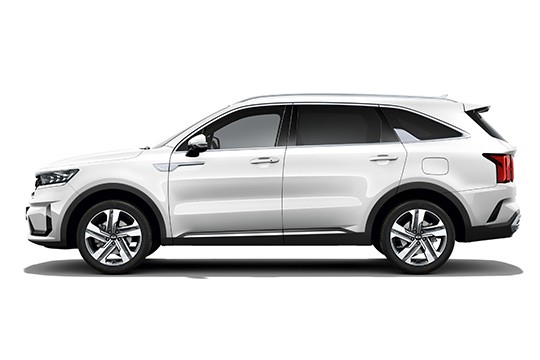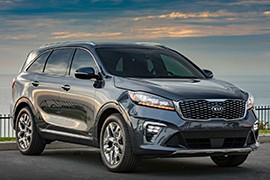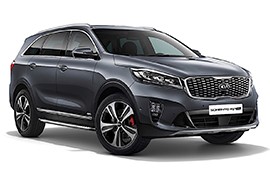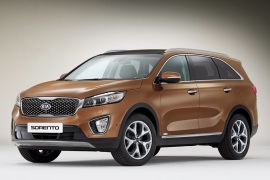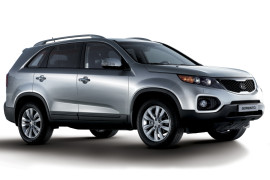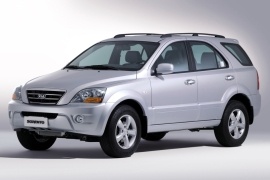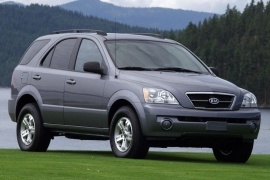KIA Sorento Models/Series Timeline, Specifications & Photos
First production year: 2002
Engines: Hybrid, Plug-in hybrid, Diesel, Gasoline
Body style: SUV (Sports Utility Vehicle)
Most probably, 10 years ago, we would’ve never though that KIA would evolve the way they did over the past years. And since their cars became better and better, their cost increased as well.
The KIA Sorento’s price launched in 2020 was the highest compared to the previous models and had a lot to offer.
The most notable aspect is that the new Sorento offered 7 seats and that made it an ideal car for large families.
The Sorento came with only one engine version, a 2.2-liter diesel developing 198 hp. It was available with a 4-wheel drive and the standard included a 6-speed manual transmission. Buyers also had the option to choose an 8-speed automatic transmission.
The interior offered comfort due to the available adjustments for the seats (8-way electric adjustments or a 10-way electric adjustments available for the KX-3 and the GT Line S trim levels). The controls were intuitively placed, in a way that allows the driver to use them in a safely manner. For a non-premium SUV, the materials used did not look cheap, moreover, the dashboard looked as if it was all wrapped up in leather.
The road visibility offered by the Sorento was beyond reproach, due to its large windscreen and the “throne-like” seating position, plus thins pillars. The overall feeling was of safety and control.
The infotainment system offered both Apple Car Play and Android Auto, with a 7.0 inch or a 8.0 inch touchscreen depending on the trim level. The more expensive trim levels offered improved audio with the aid of 10 Harman Kardon speakers.
Kia refreshed its best-selling model on the U.S. market, the Sorento, in 2018, four years after introducing the third generation.
The Korean carmaker noticed the Americans' appetite for SUVs and burned the midnight oil to make an excellent one: the Sorento. Please make no mistake; it wasn't the best in its class nor the most beautiful or more powerful. It wasn't best on anything, actually, but it had that mix of "little bit of everything" that transformed it into the best-selling Kia on the North American market.
On the outside, the designers worked hard to create a car that looked the same, but it was different in its details. The front bumper got a crispier look, and, depending on the trim level, it received LED fog lamps. A chromed trim adorned the side scoops, and most importantly, the headlights received LEDs for the upper trim levels (SX and SXL).
Inside, the carmaker kept what the customers liked at most and changed what they wanted the least. As a result, there was a new gear-knob. The design team removed the sliding cover for the cup-holders on the center console. It looked like Sorento's customers moved that away when they bought the car and never pulled it back. Like its predecessor, the 2018 Sorento featured heated and ventilated front seats and heated middle ones. No one cared too much for the last row since they were seldom used and only for short distances.
Under the hood, the Sorento received important updates. Kia dropped the 2.0-liter turbocharged unit. That left the seven-seat SUV with only two engine options. On the plus side, Kia got rid of the six-speed automatic gearbox and introduced a newly developed eight-speed automatic transmission.
While most of the midsize crossover SUVs looked pretty much the same, the 2017 Kia Sorento had a distinctive exterior design, as well as a good price.
The harmoniously styled SUV kept the buyers’ eyes entertained and it was offered with 5 different trim levels, as well as 3 powertrain options.
Jumping in the top-of-the-range SX Limited and ignoring the KIA badges, the stylish crossover made their occupants feel like they were siting in a premium vehicle. The cabin was fitted with premium Nappa leather - although only two color choices were available, upscale polished metallics and gloss finish trims.
The control layout was simple, with intuitive and easy to use buttons. The Kia’s infotainment system was intuitive too, with everything logically arranged.
Providing a nice combination of manoeuvrability and versatility, the Kia Sorento was available in two configurations: a 2-row setup (the L, the SX Limited and the EX trim levels ) or a three-row layout (EX V6 and the SX trim levels), offering seating for five, respectively 7 passengers.
The least expensive Kia Sorento in the base L trim level was equipped with standard 17-inch alloys, fabric upholstery, Bluetooth connectivity and split-second-row seats.
The upper trim levels added available optional packages such as the Convenience, the Advanced Technology, Premium and the Touring package.
Receiving a 5-star rating at the government crash tests, the Sorento was one of the safest crossovers available on the market at the time, available with many active and passive safety features.
Kia introduced the third generation of the Sorento for the European market in 2014, proving the carmaker’s determination to become a major player in the large SUV segment.
The third generation of the Sorento for the European market was released at the 2014 Paris Motor Show in September, after the global debut that happened in August in Seul. Like its predecessor, it was a monocoque construction, only this time, it shared its platform with the Kia Carnival MPV. As a result, it could be offered with three-row seating and several features that made it a better people carrier.
In addition, the increased percentage of high-strength steel usage made the bodywork stiffer and safer. With the 2014 Sorento, the Korean automaker challenged other big players in the SUV segment, such as Land Rover Discovery Sport or Volvo XC90.
Kia’s new design language, imagined by Peter Schreyer in 2006, along with the first generation of the cee’d, evolved over time. It was expanded and applied to the rest of the range, so by 2014, it had become well-established in the carmaker’s inventory. The Sorento featured a broad grille pinched at the top, in the middle, following the “Tiger nose” concept created by the German designer.
The swept-back headlights that were available with Xenon brights. From its profile, the large SUV showed a long greenhouse with triangular windows behind the rear doors. The slightly tilted forward tailgate was adorned by a roof spoiler and was fitted as standard with power opening and closing.
Inside, for selected markets, the 2014 Sorento came fitted as standard with three rows of seats and room for seven passengers. At the front, the automaker installed a pair of bucket seats separated by a wide center console. There, Kia installed the gear stick and several storage areas, including a pair of cup holders. On the center stack, the automaker offered the option for an eight-inch touchscreen infotainment unit with a reversing camera.
The front seats and the outboard middle-row seats were available with heating, a feature that not many full-size SUVs had at that time. There was enough room for three passengers in the middle row on the split-folding (40/20/40) bench seat that allowed the occupants easy access to the third row of seats. All but the front seats could be folded easily from the trunk area using distinct levers.
The technical bits of the third generation of the Sorento showed the automaker’s concern about safety and comfort. As a result, the independent suspension in all corners was enhanced with additional bushing that reduced road noise and vibrations. Also, the automaker offered advanced safety features such as adaptive cruise control, lane departure warning, front collision warning, lane change assist, and others.
Under the hood, depending on the market, the Sorento was available with either a 2.2-liter turbo diesel or a 2.4-liter gasoline direct injection powerplant. These four-pot engines were mated with either six-speed manuals or six-speed automatics.
The Korean automaker introduced the second generation of the Sorento in 2009 and brought a fresh design for its flagship Crossover Utility Vehicle.
Kia was no longer associated with manufacturers of small-sized vehicles. Its Sorento was just one of them but, perhaps, the most important. Besides showing an improved design, it also boasted better engines in terms of fuel efficiency and performance and a higher-quality for the cabin.
With Peter Schreyer leading the design department, the Korean automaker started to look more appealing to its customers. Thus, the Sorento looked more like an up-scale vehicle rather than a mundane one, like its predecessor. At the front, the grille sported the new “Tiger-nose” design language, with its pinned-down upper and middle sections. The headlights showed an angular, sharp look with ascending outer sides. On the lower bumper, the fog lamps were placed in large clusters flanking the lower trapezoidal grille. From its profile, the SUV's stance was emphasized by the widened wheel fenders and the ascending sculptured line from the doors. Finally, at the back, the tailgate was slightly tilted forward, and the taillights were shared between it and the rear quarter panels.
Inside, the automaker offered enough room for up to seven seats, depending on the options. The dashboard of the Sorento featured a binocular instrument cluster with a center-mounted speedometer flanked by the rev counter on the left and a few gauges on the right. In addition, an LCD showed data from the onboard computer. As an option, the Sorento was available with a panoramic glass roof, a feature mostly seen on premium vehicles.
Underneath the bodywork, the car featured a new technical platform. Depending on the market, the Sorento was available with gasoline or turbo-diesel engines paired with either manual or automatic gearboxes. Unlike its predecessor, the 2009 Sorento was based on a unibody construction, not on a body-on-frame one.
Kia unveiled the facelift for the Sorento's first generation in 2006, four years after the model's introduction.
The Korean carmaker already had some experience in building 4x4 vehicles, and it tried to get a more significant share of the market with the introduction of the Sorento lineup in 2002. It was built on a body-on-frame system, and it was Kia's first attempt to enter the mid-size SUV market. The result was more than satisfactory since the carmaker offered the vehicle at a price well below its competitors.
At the front, the main difference between the facelift and the non-facelift version was on the headlights. The carmaker moved the turn-signals on their lower outer side in a colored horizontal strip. Kia modified the grille, introducing a three-slat one instead of the previous one that featured one horizontal bar in the middle. In the rear, the taillights received a new design with smaller reversing lights. Depending on the trim level, the 2006 Sorento featured body-colored bumpers.
Inside, the carmaker offered more airbags than before, and that brought the car into the five-star crash-test rating performed by the NHTSA in frontal and side-impact. A major improvement was the dashboard, which was available in gray or tan with wood-trims on the center stack and door panels.
The most significant upgrade was under the hood. For the U.S. market, the Sorento replaced the older 3.5-liter engine with two new ones of 3.3-liter and 3.8-liter displacement. For specific markets, the Korean carmaker installed a 2.5-liter turbo-diesel.
Kia stepped up its game and entered the mid-sized SUV market with the Sorento in 2002, a vehicle sold worldwide under the same nameplate.
The Korean carmaker was not new to the world of body-on-frame 4x4 vehicles. It already had the first generation of the Sportage. In its history, several other vehicles followed the same construction. However, after its marriage with Hyundai in 1997, the company was upgraded, and the results followed. The Sorento was one of the most important vehicles in the carmaker's lineup and showed the world that it could produce good quality, affordable SUVs.
Born in the middle of the new-edge design trend, the Sorento sported a front fascia dominated by curved lines and sharp angles, especially on the headlights. Moreover, to emphasize its off-road capability, the car featured a gray, unpainted lower bumper area, depending on the trim level. From its sides, the greenhouse offered a profile similar to a station wagon, just higher. In addition, the curved tailgate was extended all the way to the bumper to ease up the loading and unloading.
Inside, the high seating position was appropriate for an SUV. Even though the materials used were average, the layout was clean and logical. On the center stack, Kia installed the audio system on top, which was easy to reach by the driver. Moreover, there were controls on the steering wheel. At the back, there was room enough for three passengers.
Kia installed a front independent suspension on the Sorento that enhanced comfort, while the back was supported by a live axle. Power went to the rear or in all corners via a two-speed transfer case activated by a rotary knob on the dashboard. Depending on the market, the carmaker installed a 2.5-liter turbo-diesel engine or a choice of two gasoline-fed powerplants.
